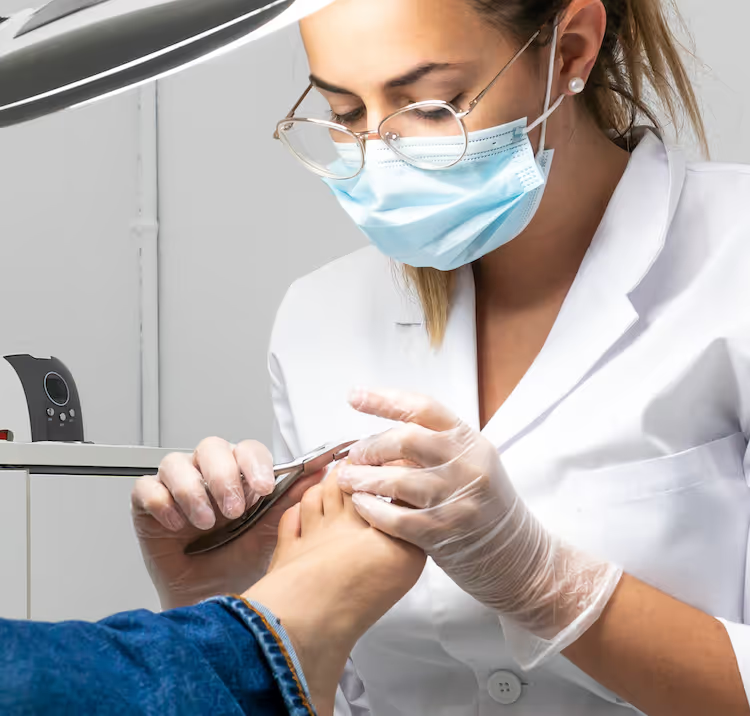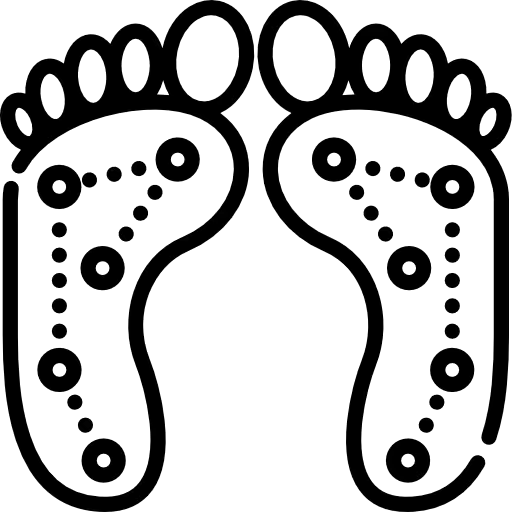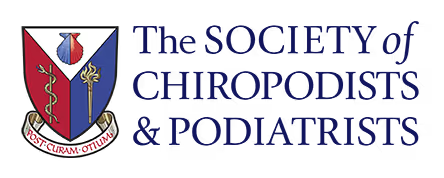
Podiatry
Diagnoses & Treatments
Other initials to look for are:
BSc(Hons) Pod - Honours degree in Podiatric Medicine
DPodM - Diploma in Podiatric Medicine
FCPodS - Fellow of the College of Podiatric Surgeons
MCPodS - Member of the College of Podiatric Surgeons
FChS - Fellow of the Chiropody Society
Alternatively search the Society of Chiropodists and Podiatrists website at www.feetforlife.org or the health professions council on www.hcpc-uk.org
The HCPC (Health & Care Professions Council) has now protected the titles Chiropodist and Podiatrist.
Your concerns or conditions will be discussed and treatment options offered to provide a solution or resolution. Treatment may commence with your consent, using instruments sterilised to clinical standard guidelines assuring optimum infection control.
The most common conditions which can be treated at the Clinic include general Chiropody, corn and callus treatment, ingrown toenails, fungal nail / skin infections and verruca (e) virus.
We also manage foot problems related to chronic medical conditions such as Diabetes, Osteo / Rheumatoid Arthritis and Parkinson’s foot care including vascular and neurological assessments to monitor patient’s foot health requirements.
Additionally a range of biomechanical problems can be treated including painful conditions such as plantar fasciitis, bursitis, heel spurs, achilles tendonitis and neuroma pain; if in doubt please contact the clinic for further advice or information. As Podiatrists we are health care professionals able to give you and your family advice on how to look after your feet and guidance in which types of shoes to wear, we treat and alleviate day-to-day foot problems, which are listed below:
Cosyfeet
Clarks
DB
Ecco
Gabour
HotterJosef
Seibel
Padders
Please don’t ignore foot pain, either see a Podiatrist (Chiropodist) or visit your GP who may refer you to a Podiatrist in order to investigate the underlying cause of your foot pain; improve your quality of life today.
Useful links
Athletes foot
Athlete’s foot is a rash caused by a fungal infection which usually appears between the toes, however, can present in other locations of the foot.
The affected skin may be itchy, red, scaley, dry, cracked or blistered. The condition is not usually serious although is infectious and should be treated to prevent it from spreading to other parts of the body or other people.
Blisters
Blisters are small pockets of fluid that form in the upper layers of the skin due to friction and pressure and are either clear fluid (serum), however, may be blood blisters or pus pockets if they become inflamed or infected.
If blisters are left untreated or present in a person with a compromised immune system they can lead to more serious problems such as infections and ulceration.
Bunions / tailor’s bunions
A Bunion is a bony deformity of the joint at the base of the big toe, the medical term is hallux Valgus. It is also possible to acquire a tailor’s bunion which is a prominence of the fifth metatarsal bone at the base of the little toe.
The main sign of a bunion is the big toe pointing towards the other toes on the same foot causing the toes to move closer together and the joint to become prominent. Symptoms may include, pain and swelling to the toe/joint, red inflamed skin and callus, occasionally overlapping and retracted/hammer toes changing the shape of your foot. The Podiatrist will discuss a number of treatment options for bunions, non-surgical treatments are explored first which can help to reduce pain symptoms and make your feet more comfortable. If bunions are not treated they can lead to further problems such as second toe misalignment (retracted/hammered toes) also causing arthritis in the big toe joint.
Corns and callus
Corns and calluses are areas of hard, thickened skin which develop when the skin is exposed to excessive pressure and friction, commonly occuring on the feet and can result in discomfort and pain when walking.
Corns are small areas (circles) of thick skin that can develops on any area of the foot where pressure or friction is exerted, often caused by:
*Shoes that may be too tight or loose allowing the foot to slide and rub.
*Shoes styles which place excess pressure on an area of the foot or squeeze the toes.
*Bunion joints or hammer toes joint prominences rubbing or pressing in unaccommodating shoes.
Diabetes
Diabetes may affect your feet in a number of ways and in some cases can lead to serious complications.
Diabetes can lead to changes to the circulation and sensation of the feet, therefore, it is important that Diabetic patients receive an annual foot assessment in order to identify and monitor any reduced blood flow to the lower limb, which may affect your ability to heal and risk of ulceration; also to identify any loss of sensation (neuropathy) and reduce any associated risks of Diabetes complications.
Simple day-to-day advice will be given to help you keep your feet in good health in order to help you prevent and delay any changes affecting your feet.
Fungal nails (also thickened and discoloured nails)
Many people at some stage in their life may develop a fungal nail infection, which is not usually serious, however, can be unpleasant and difficult to treat.
The medical name for a fungal nail infection is onychomycosis, nail infection starts slowly and causes the nail to become discoloured, thickened, sometimes eroded and distorted.
Often thickened and discoloured nails may be signs of a fungal nail infection but this is not always the case, the Podiatrist can tell you if you have a fungal infection and discuss possible treatment options available to prevent infection from spreading to healthy nails and skin.
Gout
Gout is a type of arthritis when small uric acid crystals form inside and around the joints causing sudden attacks of pain and swelling.
Signs and symptoms of gout include:
Severe pain in one or more joints
Swelling in and around the affected joint
The joint feeling hot and tender
Red inflamed, shiny skin over the joint
Gout is caused if there is a build-up of uric acid in the blood, tiny sharp crystals form around the joint of toes, ankles, knees and fingers and can be extremely painful and debilitating, however, there are treatments available to prevent further attacks.
Hammer toes
Hammer toe is a deformity of the second, third or fourth toe, when the toe appears permanently bent at the joint.
There are a number of causes of hammer toe. Ill-fitting shoes are a common culprit. Injury, bunions or rheumatoid arthritis are other causes.
Hammer toe can cause other problems. Because the toe joint sticks out, it is more susceptible to shoes rubbing, meaning corns and calluses can develop. Hammer toes can also cause stress on the ball of the foot, which can lead to pain known as metatarsalgia.
Heel pain (including plantar fasciitis)
Heel pain is a common foot condition, it is usually felt as an intense pain when weight bearing and using the affected heel.
Generally heel pain usually builds up gradually and worsens over time, in most cases only one heel is affected; reported to be worse in the morning getting out of bed then after a period of inactivity or standing / walking for longer periods. Frequently people develop an abnormal walking style or limp when the pain gets worse to offload the area. There are several different causes of heel pain such as:
Plantarfasciitis is the most common cause of heel pain, which would account for around four out of five cases presented.
The plantar fascia is a thick band of tissue that connects to the heel bone to the rest of the foot and toes which becomes damaged and thickened which can happen suddenly while jogging and dancing affecting younger physically active people, however, adults aged over 40yrs can experience gradual wear and tear of the plantar fascia tissues resulting in injury.
Less common causes of heel pain may be related to:
Stress Fracture - A crack in the bone can occur if the heel bone is damaged following repeated stress over time.
Fat pad atrophy – The layer of fat that lies under the heel bone is known as the fat pad can start to waste away due to too much strain being placed upon it. Women especially increase their risk of developing fat pad atrophy due to wearing high heel shoes for many years.
Bursitis – inflammation of the bursa (small fluid filled sacs under the skin) usually located over joints to cushion and protect the areas between tendons and bones, frequently affects the heel area.
Tarsal tunnel syndrome – The nerves located in the sole of the foot pass through a small tunnel on the inside of the ankle joint called the tarsal tunnel. Occasionally a cyst forms or the tunnel becomes damaged, whereby the nerves can become compressed (squashed) causing pain along the course of the nerve and under the heel.
Sever’s Disease – A common cause of heel pain in children caused by calf and hamstring muscles and tendons stretching and tightening in response to growth spurts. When the calf muscle is stretched this pulls on the Achilles Tendon which strains the growth plate (the growing area at the back of the heel) causing pain in the heel. Severs pain is generally experienced at the side and under the heel, further aggravated by sporting activity such as football and gymnastics.
Bone Spurs – An excess growth of bone that forms on normal bone. Commonly found in people with heel pain (heel spur), although, they can also occur in people without heel pain.
Hyperhidrosis (also bromhidrosis, smelly feet)
Hyperhidrosis is a common condition in which a person sweats excessively and may affect the whole body or may only affect certain areas. The condition does not usually pose a serious threat to your health but can be embarrassing and distressing.
Bromhidrosis
Smelly feet associated with hyperhidrosis sin condition can be treated at home using effective and simple treatments to help banish foot odour quickly. The main cause of this condition is sweaty feet combined with wearing the same shoes every day and exacerbated by athlete’s foot.
Bacteria on the skin breaks down sweat as it comes from the pores and a cheesy odour is released as the sweat decomposes.
If you suffer from these conditions and your sweating has started to interfere with your everyday life then you may have hyperhidrosis and your Podiatrist can advise you regarding treatment of this condition and your GP will usually be able to diagnose the condition and check for an underlying cause.
Ingrowing nails (nail surgery)
An ingrowing toenail develops when one or both sides of the nail grow into the surrounding skin. The nail curls into and pierces the skin which becomes, tender, red and swollen.
Frequently the big toe is affected on one or both sides where symptoms include, pain upon pressure, inflammation in the area, possibly overgrowth of surrounding skin and bleeding, white or yellow pus from the area.
Ingrowing toenails are often caused by poor nail cutting, badly fitting shoes, sweaty feet, injury or due to the natural nail shape. In most cases the nail can be resolved painlessly by careful removal of the nail spur/spike and dressing the toe to prevent infection, however, without treatment the area can become infected and surgical removal of part of the nail may be recommended.
Nail surgery
If ingrowing nails are treated early most can be dealt with conservatively with routine treatment by a Podiatrist combined with self-care at home, however, in chronic conditions or where conservative treatment has not been successful then nail surgery may be appropriate.
Occasionally ingrowing toenails may be too deep or too painful to be treated conservatively, therefore, nail surgery may be required to carefully remove the side which is affected and a chemical applied to ensure the nail does not regrow in the same manner. This procedure can be performed in clinic following a full assessment for suitability under a local anesthetic for minor nail surgery, if the patient and Podiatrist agree that nail surgery is the best course of treatment for their condition.
Morton’s neuroma
Morton’s neuroma is a painful condition which affects the nerves between the toes, it is also known as metatarsalgia or interdigital neuroma.
This condition can occur in one or both feet, usually affecting the nerves between the third and fourth toes when the nerve becomes irritated and thickened resulting in pain. Initially you may experience a tingling sensation between the toes which over time develops into a sharp shooting or burning pain in the ball of your foot or at the base of the toes, possibly also some numbness in your toes; exacerbated by walking or wearing tight shoes.
If you are experiencing persistent symptoms of Morton’s neuroma it would be a good idea to make an appointment to see a Podiatrist or a GP who may refer you to a Podiatrist, as the condition is unlikely to improve on its own.
Numb and swollen feet
If you are experiencing any areas of numbness or loss of sensation or if you have any swelling in your feet (with or without pain) which is unusual for you, then you should see your GP or Podiatrist as soon as possible. It may be something less serious causing these changes, however, it may be more serious such as an infection, broken bone or tendon rupture.
Verruca(e)
Verruca(e) and warts are caused by the human papilloma virus (HPV), which causes an excess of hard skin called keratin to develop in the top layer of skin, resulting in a hard, rough lump.
Most people develop warts or verruca(e) at some stage in their lives, generally they are harmless and tend to go away on their own, but this can take months or even years. On occasions verrucae can be painful and problematic by spreading, therefore, stubborn verrucae require treatment to reduce the risk of infection spread, maintain comfort and help speed up eradication if you find them painful or embarrassing. While you have a wart or verruca, you should also take steps to avoid passing it on to others.








